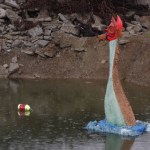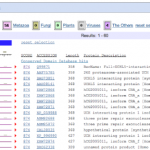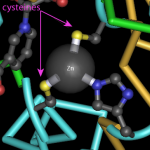
That's how new life forms are created every day in the wild, folks. Human researchers of course have added a few twists on the theme. If we can't induce bacteria or animal cells to collect new bits of DNA on their own, we turn to electroshock therapy. With plants.... aw heck, we just shoot them.
And where did this crazy rant come from you ask? Last Saturday morning, at the crack of 9 am I got to be interviewed on a radio program with two of the main spokespeople from the DIY bio movement, Mackenzie Cowell and Meredith Patterson.
The program was "The Food Chain" (you can listen to it…
This is a video that a friend made that shows, very clearly, how to pour an agarose gel, load the samples and run it. I especially like the way he used a bit of time lapse photography to show the dyes separating as the gel ran.
"Yo, you regulate it's genes"
The English makes me cringe, but I love the idea. Tom McFadden, an associate instructor at Stanford, has made a series of Biology rap videos and posted them on YouTube.
Yo, check it out.
We saw it this morning while walking the dog.
Figure 1. A sign nearby claims this is a "Seagle."
Figure 2. The ducks must think swimming is safe.
If you haven't seen these, check out Jake Young's collection of videos showing T cells getting infected by HIV. The best one is at the bottom of the post.
A few weeks ago I heard a story from a friend in Oklahoma. She works with high school science teachers, helping them learn how to add biotechnology to their courses.
One teacher, in particular, has taken the new science activities to heart. Her students did so well, they won a science competition and were asked to fly somewhere to accept the prize.
For many of those students, this would be their first trip on an airplane and their first trip outside of rural Oklahoma. It was pretty exciting!
But there were some unexpected problems.
Some of these children were illegal.
Just like the…
Watching the chIPs roll in,
then I watch them roll away again,
I'm just sitting on the DNA,
wasting time
(sung to the tune of "Sitting on the dock of the bay" by Otis Redding)
Hesselberth et.al. recently published a paper about digital genomic
footprinting that blew me away because it has so much potential. The authors used DNAse I and Next Generation DNA Sequencing to map every site in the yeast genome where a protein might be sitting.
Since I used to do similar kinds of experiments, albeit on a much, much smaller scale, this sort of publication boggles my mind. It's only recently that I've…
The NIH has some extra money to fund summer research for students and teachers.
Check it out!
The NIH and grantee partner institutions have a unique opportunity to support summer research experiences for high school and college students, as well as elementary, middle, and secondary school science teachers, and faculty from non-research intensive institutions in your geographic area. Supported through American Recovery & Reinvestment Act of 2009 (ARRA), these administrative supplements are available, on an expedited basis, to NIH research grants of faculty at your institution (See…
I don't usually publish press releases, but I'm making an exception for this one, since your's truly is one of the Co-PI's. If you're a teacher within commuting distance of Seattle, the schedule and sign up information is here.
NSF AWARDS $1.3 MILLION TO NWABR FOR BIOINFORMATICS EDUCATION
Innovative Technology Experiences for Students and Teachers (ITEST) brings the understanding of how biology and information technology interact to teachers and their students
Seattle, WA - March 26, 2009 - The Northwest Association for Biomedical Research (NWABR) has been awarded a $1.3 million dollar…
In which we identify unknown human proteins.
Yesterday, I wrote about using the BLOSUM 62 matrix to calculate a score for matches between two proteins. Those scores give us a good start on understanding how blastp determines whether two sequences are matching by chance or because they're more likely to be related. But that's not all there is to calculating a blast score, and there's at least one other statistic to consider as well, the E value.
It all comes down to biochemistry
The BLOSUM 62 matrix is based on the substitutions that really do or do not happen in real protein sequences. I…
In which we search for Elvis, using blastp, and find out how old we would have to be to see Elvis in a Las Vegas club.
Introduction
Once you're acquainted with proteins, amino acids, and the kinds of bonds that hold proteins together, we can talk about using this information to evaluate the similarity between protein sequences. We can easily imagine that if two protein sequences are identical, then those proteins would have the same kind of activity. But what about proteins that are similar in some regions, and not others, or proteins that only share some of the same amino acids in similar…
For the past few months, the shake-up that began with Next Generation DNA Sequencing has been forcing me to adjust to a whole new view of things going on inside of a cell. We've been learning things these past two years that are completely changing our understanding of the genome and how it works and it's clear we're never going back to the simple view we had before.
What's changed? The two most striking changes, to me at least, are the new views of the way the genome is put together and what the cell does with the information.
They just don't assemble chromosomes like they used to.
I used to…
What do the missing Romanov children, genetically engineered humans, financial risk taking, and poop have in common?
You can read about all these topics from this month's Gene Genie carnival at Mary Meets Dolly.
Who would have thought that mutations could be so much fun?
Cofactor Genomics is offering to sequence a genome for a few classes for free using Next Generation DNA Sequencing technology (either Illumina GA or via AB SOLiD).
Quoting from their site:
Cofactor will ask course organizers for a 1 page description of how their ~700Mb sequencing project could be used as an effective teaching aid in their class. We will review and choose the best entries during the month of May. Those entries will be awarded a free sequencing project including project experimental design, sample QC, library construction, sequencing, and computational analysis. Those projects…
I guess I put my foot in it when I wrote that Genome Technology article on DIY Bio. I've already gotten a couple of e-mails today and I can see on the Google groups DIY bio section, that I managed to offend some people by suggesting doing biotechnology successfully at home might mean that you actually have to learn some biology.
Funny, huh?
It's like I suggested something heretical. People have to learn how to program to write software, don't they? I don't see that doing biotechnology as a hobby would be any different.
Anyway, here's my response to the DIY google group critics. I've…
"Digital biology," as I use the phrase, refers to the idea of using digital information for doing biology. This digital information comes from multiple sources such as DNA sequences, protein sequences, DNA hybridization, molecular structures, analytical chemistry, biomarkers, images, GIS, and more. We obtain this information either from experiments or from a wide variety of databases and we work with this information using several kinds of bioinformatics tools.
The reason I'm calling this field "digital biology" and not "bioinformatics" (even though I typically use the terms as…
A friend of mine; serial entrepreneur, and former president of Genetic Systems; Joe Ashley, told me once that starting a business is an unnatural act.
Now that I've done it, I agree. Even with my multiple back-up plans, possible grants, and part-time activities, my stomach still hurts and my mind is racing. My new company has "spun out" of another. Spinning out of control until you fall down from exhaustion. It's a great metaphor all right.
Sure, there's excitement and adventure. I love my new shiny business cards and my new shiny web site! It's fun to do things that I like and would…
Have you ever wondered how to find things in the NCBI databases? Maybe you tried to find something but didn't know how it was spelled. Or maybe you tried to use a common name like "pig" or "deer" to find information in a database, not knowing that all the organism names are in Latin. Or perhaps you're wondering just what kind of information is stored for different kinds of records and if you could search for this information.
I wrote a book that covered this topic quite thoroughly, a couple of years ago, for the NCBI structure database. Now, I've decided to make some movies, too.
This…
The auditorium could have been empty as I focused on the slide overhead. Questions formed out the mist, and my heart pounded as I took a deep breath and began to my raise my hand.
"Da da da dah! Da da da dah, da da da da da da da dah!!"
Oh, NO! The theme song from Indiana Jones! Coming from my backpack! Thousands of eyes turned disapprovingly to stare at my red face. Scrambling frantically over people to reach the aisle, I ran out the back of the room and answered the phone.
"Hi, my name is Tim, and I'm looking for a financial advisor in your area…
A long-sought goal in genetics has been to develop therapies that can use correctly functioning genes to replace genes with defects. If we had the technology to predictably modify our genomes, we would have the ability to cure many diseases instead of having to place people on medications for their entire lives.
For a long time, gene therapy has remained an elusive dream. But, in the past few years the dream has come closer to reality, especially in the case of ten children, who live because of researchers who kept that dream in sight (1).
Figure 1. Random children
Technorati Tags:…






